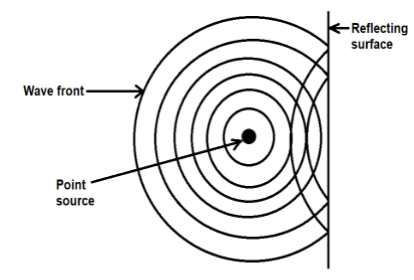
Spherical wave fronts, emanating from a point source, strike a plane reflecting surface. What will happen to these wave fronts, immediately after reflection?
Answer
491.7k+ views
Hint: The locus of all points of the medium that vibrate in the same phase is known as a wave front. Wave fronts may be one of three styles, depending on the shape of the light source. A wave front is a line or surface in the direction of wave motion that has the same phase of disturbances at all points. If a wave front diverges, the energy conveyed by the wave spreads over a bigger and bigger region, and thus, the intensity decreases. The force of a plane wave is steady since plane wave fronts neither converge or diverge.
Complete answer:
Depending on the source of light, wave fronts may be one of three types: cylindrical wave front, spherical wave front, and plane wavefront are the three types of wave fronts.
Spherical Wave Front: When a point source emits waves in three dimensions in an isotropic medium, the wave fronts are spheres centred on the source. A spherical wave front is one such wave front.
Cylindrical wave front: When the source of light is linear, all the points equidistant from the linear source lie on the surface of a cylinder. This type of wave front is called a cylindrical wave front.
Plane wave front: The wave front obtained when a fraction of a spherical or cylindrical wave front originates from a distant source such as infinity is known as a plane wave front.
Spherical Wave Front diagram:

When light is emerging from a point source, the wave fronts are observed to be spherical in shape. In spherical wave front, amplitude of light waves, \[A \propto \dfrac{1}{{{r_1}}}\]. And Intensity of light waves, $I \propto \dfrac{1}{{{r_1}^2}}$. The wave front will remain spherical after reflection from the surface but their direction of propagation will be revered.
Note: The term "wave regular" refers to a perpendicular drawn to the surface of a wave front at any point in the direction of light propagation. A ray of light is the direction in which light travels. As a result, a wave normal is the same as a light beam. The appearance of wave fronts can be altered with the use of a lens.
Complete answer:
Depending on the source of light, wave fronts may be one of three types: cylindrical wave front, spherical wave front, and plane wavefront are the three types of wave fronts.
Spherical Wave Front: When a point source emits waves in three dimensions in an isotropic medium, the wave fronts are spheres centred on the source. A spherical wave front is one such wave front.
Cylindrical wave front: When the source of light is linear, all the points equidistant from the linear source lie on the surface of a cylinder. This type of wave front is called a cylindrical wave front.
Plane wave front: The wave front obtained when a fraction of a spherical or cylindrical wave front originates from a distant source such as infinity is known as a plane wave front.
Spherical Wave Front diagram:

When light is emerging from a point source, the wave fronts are observed to be spherical in shape. In spherical wave front, amplitude of light waves, \[A \propto \dfrac{1}{{{r_1}}}\]. And Intensity of light waves, $I \propto \dfrac{1}{{{r_1}^2}}$. The wave front will remain spherical after reflection from the surface but their direction of propagation will be revered.
Note: The term "wave regular" refers to a perpendicular drawn to the surface of a wave front at any point in the direction of light propagation. A ray of light is the direction in which light travels. As a result, a wave normal is the same as a light beam. The appearance of wave fronts can be altered with the use of a lens.
Recently Updated Pages
Why are manures considered better than fertilizers class 11 biology CBSE

Find the coordinates of the midpoint of the line segment class 11 maths CBSE

Distinguish between static friction limiting friction class 11 physics CBSE

The Chairman of the constituent Assembly was A Jawaharlal class 11 social science CBSE

The first National Commission on Labour NCL submitted class 11 social science CBSE

Number of all subshell of n + l 7 is A 4 B 5 C 6 D class 11 chemistry CBSE

Trending doubts
What is meant by exothermic and endothermic reactions class 11 chemistry CBSE

10 examples of friction in our daily life

One Metric ton is equal to kg A 10000 B 1000 C 100 class 11 physics CBSE

1 Quintal is equal to a 110 kg b 10 kg c 100kg d 1000 class 11 physics CBSE

Difference Between Prokaryotic Cells and Eukaryotic Cells

What are Quantum numbers Explain the quantum number class 11 chemistry CBSE




